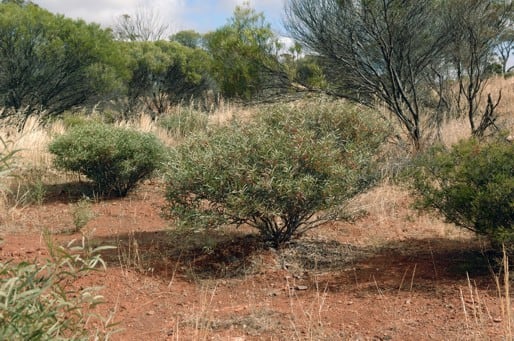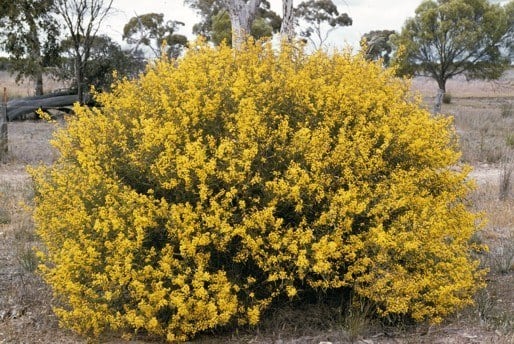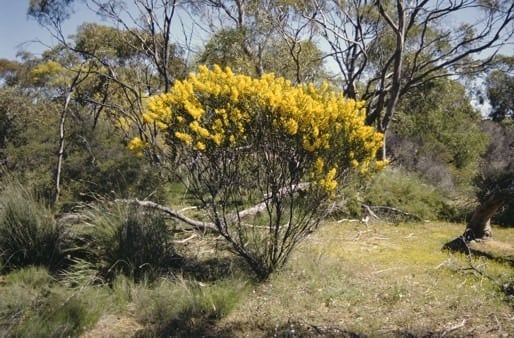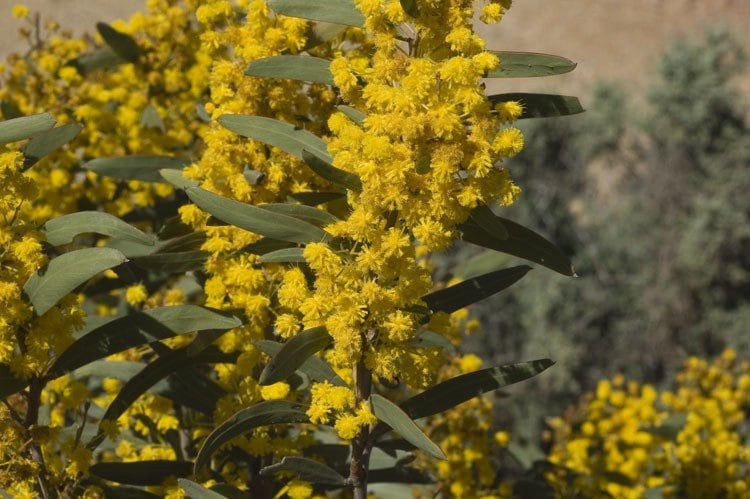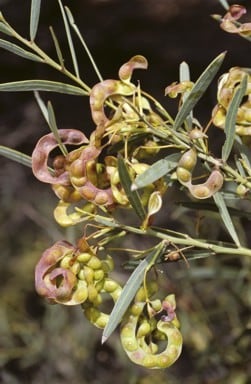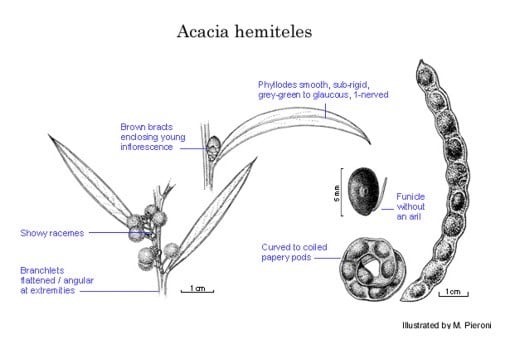Acacia hemiteles Benth.
WATTLE
Acacias of Australia
Common Name
Tan Wattle, Broombush
Family
Fabaceae
Distribution
Occurs from Kanandah Stn, Nullabor Plain, W to near Ongerup and Canna, W.A. There is also a recent collection from near Maralinga, S.A. Often locally common.
Description
Dense spreading multistemmed glabrous shrub 0.5–2 m high. Branchlets angled to flattened at extremities; cuticle often white. Phyllodes patent to erect, narrowly elliptic to ±narrowly oblong or linear, narrowed at both ends, straight to recurved, (2–) 4–10 cm long, (3–) 4–9 mm wide, acute to subacute, innocuous to ±pungent, subrigid, smooth, greyish green, often glaucous when young; midrib and margins prominent; lateral nerves absent or obscure; gland 0–3 mm above pulvinus. Inflorescences normally 4–7-headed racemes; raceme axes 6–16 mm long, enclosed when young by imbricate brown bracts; peduncles (3–) 5–11 mm long, slender; heads globular, 20–30-flowered, golden; bracteoles absent. Flowers 5-merous; sepals free. Pods shallowly curved to openly 11/2-coiled, to 8 cm long, 5–8 mm wide, chartaceous. Seeds longitudinal, oblong to elliptic or ovate, 3–5 mm long, dull, dark brown to black, exarillate.
Habitat
Grows in sand, loam or clay, in woodland or shrubland, sometimes on laterite or granite rocks.
Specimens
W.A.: 211 km E of Kalgoorlie near Zanthus, T.E.H.Aplin 5709 & M.E.Trudgen (CANB, PERTH); near Kalannie on Dalwallinu Rd, A.M.Ashby 4244 (PERTH); 24 km S of Lake Grace, J.Goodwin 20 (PERTH); 3.2 km N of Moora on Geraldton Hwy, B.R.Maslin 1403 (K, NSW, PERTH); 15 km SSW of Queen Victoria Rocks, K.Newbey 5683 (CANB, PERTH). S.A.: 26 km ESE of Maralinga, L.D.Williams 9618 (AD).
Notes
A member of the ‘A. prainii group’ and close to A. prainii itself which has narrower, more pungent phyllodes; also, the branchlet ribs and phyllode margins and midrib are sometimes viscid. A putative hybrid between the two species occurs at Burracoppin (i.e. M.L.Cody s.n., PERTH00346411). Until recently A. anthochaera was regarded as a long phyllode variant of A. hemiteles; these two species also appear to sometimes hybridise.
FOA Reference
Data derived from Flora of Australia Volumes 11A (2001), 11B (2001) and 12 (1998), products of ABRS, ©Commonwealth of Australia
Author
Minor edits by B.R.Maslin & J.Rogers
B.R.Maslin
This identification key and fact sheets are available as a mobile application:
URL: https://apps.lucidcentral.org/wattle/
© Copyright 2018. All rights reserved.
